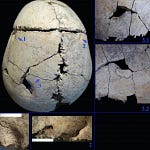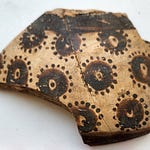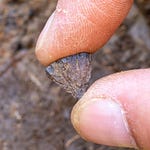Somewhere in Ice Age Eurasia, a Palaeolithic knapper leaned over a lump of flint. With a practiced hand, they struck it just so—angle, force, and point of impact carefully judged. The result was a flake shaped with intention, useful and standardized, snapped free with a single blow. For decades, archaeologists have debated how much of this was planned—and how much was just luck.

A new study published in Archaeological and Anthropological Sciences1 suggests it was anything but random. In fact, angle mattered a great deal.
The research, led by Shi-Zhu Lin and colleagues from the University of Queensland, offers a close look at one of the most distinctive and cognitively demanding stone technologies of the Middle Palaeolithic: the Levallois method. Their focus? Not the final product, but the strike itself. Specifically, how the angle of the hammer relative to the core at the moment of contact influenced the size, shape, and fracture path of Levallois flakes.
Hitting the Right Angle
The Levallois technique, widespread among Neanderthals and early Homo sapiens, involves preparing a core with deliberate convexities and striking a flake from it with a final blow. This method isn’t just about getting a sharp edge—it's about reproducibility. Levallois flakes are predictably shaped, efficient, and standardized. But the mechanics behind their detachment have remained, in many ways, a black box.
To open it, Lin and colleagues designed an experimental program to systematically vary just one parameter: the angle at which a hammerstone met the core surface. They struck over 300 flint cores using controlled angles and measured the resulting flake morphologies.
What they found was surprisingly consistent. A shallower angle of blow—closer to parallel with the core surface—tended to produce flakes that were longer and thinner, with more extensive fracture propagation. In contrast, steeper angles produced shorter, thicker flakes with different fracture paths.
“These results demonstrate that the angle of blow exerts a systematic and predictable influence on both the morphology and fracture trajectory of Levallois flakes,” the authors write.
More Than Muscle Memory
Why does this matter? Because in Palaeolithic archaeology, stone tools are among the best proxies for understanding cognition. Controlling flake shape with nuanced biomechanical precision—by managing variables like hammer angle—is not simply a manual skill. It requires foresight, planning depth, and perhaps most importantly, embodied expertise passed down through generations.
“This type of fracture control may reflect highly developed sensorimotor coordination and perceptual attunement,” the authors note, drawing connections to research in experimental psychology and skilled craftsmanship.
In other words, this isn’t just about rocks. It’s about minds at work—prehistoric bodies trained to read stone like a script and compose tools with surgical finesse.
Chipping Away at the Levallois Mystery
Previous studies have often emphasized the visual and geometric aspects of Levallois flaking: how cores are shaped, convexities maintained, and platforms prepared. But this new study highlights a subtler dimension—force dynamics in real time. By isolating a single variable in a controlled experiment, the team has shown that flake production wasn't just the outcome of shaping the core but of controlling the strike with remarkable regularity.
Importantly, this also complicates earlier assumptions that Levallois flakes were the product of core morphology alone. Instead, toolmakers may have fine-tuned outcomes with biomechanical precision, adding a previously underappreciated layer of complexity.
Neanderthals, Cognition, and Craft
What does this mean for how archaeologists interpret past behavior? If Levallois artisans actively adjusted their striking angle to produce desired flake traits, this suggests a degree of motor planning and feedback monitoring that brings us closer to understanding prehistoric cognition. It points toward learned behavior, possibly taught within social groups and practiced over years.
This also supports broader claims that Neanderthals and early modern humans weren’t so different. They weren’t just reactive beings chipping away at random. They were thinking, planning, adjusting.
“The precise manipulation of hammer angle may reflect motor expertise embedded in social learning traditions,” the authors conclude.
Related Research
Here are some related studies that provide additional context:
Lombard, M., Wadley, L., & Parsons, I. (2010). Hunting with Howiesons Poort segments: Pilot experimental study and use-trace analysis. Journal of Archaeological Science, 37(1), 1–13. https://doi.org/10.1016/j.jas.2009.07.014
– Explores hafted tools and projectile use in the Later Stone Age.Boëda, E. (1995). Levallois: A volumetric construction, methods, a technique. In The Definition and Interpretation of Levallois Technology (pp. 41–68).
– Foundational framework on the Levallois concept.Faisal, A. A., Stout, D., Apel, J., & Bradley, B. (2010). The manipulative complexity of Lower Paleolithic stone toolmaking. PLoS ONE, 5(11), e13718. https://doi.org/10.1371/journal.pone.0013718
– Quantifies the biomechanical and neural demands of early stone tool production.Hecht, E. E., Gutman, D. A., Bradley, B. A., Preuss, T. M., & Stout, D. (2015). Process versus product in Palaeolithic toolmaking: A neuroarchaeological perspective. Journal of Human Evolution, 82, 5–18. https://doi.org/10.1016/j.jhevol.2015.02.004
– Looks at brain imaging studies tied to stone tool replication.
Lin, S. C., McNaughton, M., Innes, A., Barroso-Medina, C., & Clarkson, C. (2025). Controlling Levallois: the effect of hammer angle of blow on Levallois flake morphology and fracture trajectory. Archaeological and Anthropological Sciences, 17(5). https://doi.org/10.1007/s12520-025-02222-6









